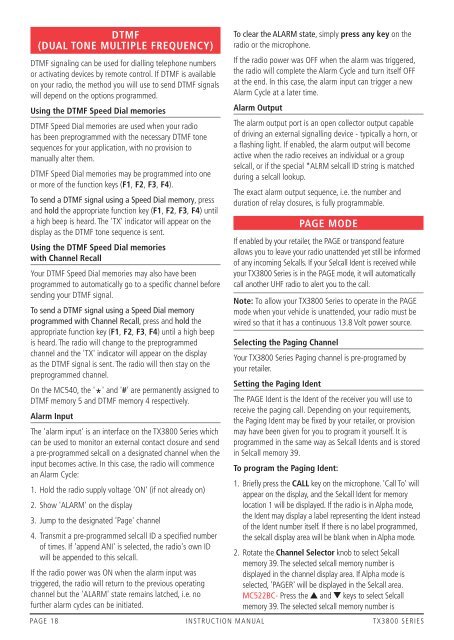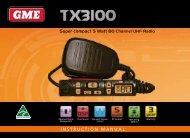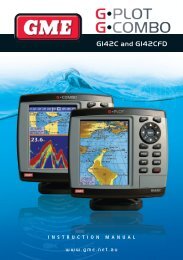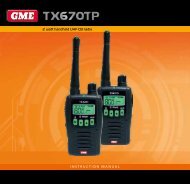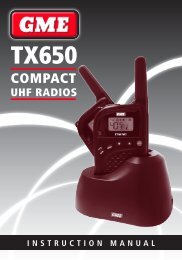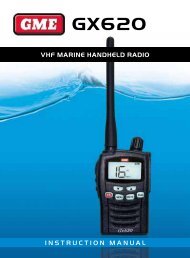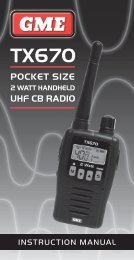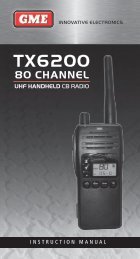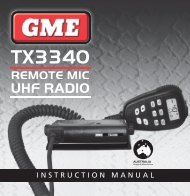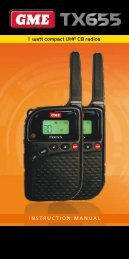gME TX3800 - Coastal Electronics
gME TX3800 - Coastal Electronics
gME TX3800 - Coastal Electronics
Create successful ePaper yourself
Turn your PDF publications into a flip-book with our unique Google optimized e-Paper software.
DTMF<br />
(Dual tone multiple frequency)<br />
DTMF signaling can be used for dialling telephone numbers<br />
or activating devices by remote control. If DTMF is available<br />
on your radio, the method you will use to send DTMF signals<br />
will depend on the options programmed.<br />
Using the DTMF Speed Dial memories<br />
DTMF Speed Dial memories are used when your radio<br />
has been preprogrammed with the necessary DTMF tone<br />
sequences for your application, with no provision to<br />
manually alter them.<br />
DTMF Speed Dial memories may be programmed into one<br />
or more of the function keys (F1, F2, F3, F4).<br />
To send a DTMF signal using a Speed Dial memory, press<br />
and hold the appropriate function key (F1, F2, F3, F4) until<br />
a high beep is heard. The 'TX' indicator will appear on the<br />
display as the DTMF tone sequence is sent.<br />
Using the DTMF Speed Dial memories<br />
with Channel Recall<br />
Your DTMF Speed Dial memories may also have been<br />
programmed to automatically go to a specific channel before<br />
sending your DTMF signal.<br />
To send a DTMF signal using a Speed Dial memory<br />
programmed with Channel Recall, press and hold the<br />
appropriate function key (F1, F2, F3, F4) until a high beep<br />
is heard. The radio will change to the preprogrammed<br />
channel and the 'TX' indicator will appear on the display<br />
as the DTMF signal is sent. The radio will then stay on the<br />
preprogrammed channel.<br />
On the MC540, the ' ' and '#' are permanently assigned to<br />
DTMF memory 5 and<br />
*<br />
DTMF memory 4 respectively.<br />
Alarm Input<br />
The 'alarm input' is an interface on the <strong>TX3800</strong> Series which<br />
can be used to monitor an external contact closure and send<br />
a pre-programmed selcall on a designated channel when the<br />
input becomes active. In this case, the radio will commence<br />
an Alarm Cycle:<br />
1. Hold the radio supply voltage 'ON' (if not already on)<br />
2. Show 'ALARM' on the display<br />
3. Jump to the designated 'Page' channel<br />
4. Transmit a pre-programmed selcall ID a specified number<br />
of times. If 'append ANI' is selected, the radio's own ID<br />
will be appended to this selcall.<br />
If the radio power was ON when the alarm input was<br />
triggered, the radio will return to the previous operating<br />
channel but the 'ALARM' state remains latched, i.e. no<br />
further alarm cycles can be initiated.<br />
To clear the ALARM state, simply press any key on the<br />
radio or the microphone.<br />
If the radio power was OFF when the alarm was triggered,<br />
the radio will complete the Alarm Cycle and turn itself OFF<br />
at the end. In this case, the alarm input can trigger a new<br />
Alarm Cycle at a later time.<br />
Alarm Output<br />
The alarm output port is an open collector output capable<br />
of driving an external signalling device - typically a horn, or<br />
a flashing light. If enabled, the alarm output will become<br />
active when the radio receives an individual or a group<br />
selcall, or if the special *ALRM selcall ID string is matched<br />
during a selcall lookup.<br />
The exact alarm output sequence, i.e. the number and<br />
duration of relay closures, is fully programmable.<br />
Page Mode<br />
If enabled by your retailer, the PAGE or transpond feature<br />
allows you to leave your radio unattended yet still be informed<br />
of any incoming Selcalls. If your Selcall Ident is received while<br />
your <strong>TX3800</strong> Series is in the PAGE mode, it will automatically<br />
call another UHF radio to alert you to the call.<br />
Note: To allow your <strong>TX3800</strong> Series to operate in the PAGE<br />
mode when your vehicle is unattended, your radio must be<br />
wired so that it has a continuous 13.8 Volt power source.<br />
Selecting the Paging Channel<br />
Your <strong>TX3800</strong> Series Paging channel is pre-programed by<br />
your retailer.<br />
Setting the Paging Ident<br />
The PAGE Ident is the Ident of the receiver you will use to<br />
receive the paging call. Depending on your requirements,<br />
the Paging Ident may be fixed by your retailer, or provision<br />
may have been given for you to program it yourself. It is<br />
programmed in the same way as Selcall Idents and is stored<br />
in Selcall memory 39.<br />
To program the Paging Ident:<br />
1. Briefly press the Call key on the microphone. 'Call To' will<br />
appear on the display, and the Selcall Ident for memory<br />
location 1 will be displayed. If the radio is in Alpha mode,<br />
the Ident may display a label representing the Ident instead<br />
of the Ident number itself. If there is no label programmed,<br />
the selcall display area will be blank when in Alpha mode.<br />
2. Rotate the Channel Selector knob to select Selcall<br />
memory 39. The selected selcall memory number is<br />
displayed in the channel display area. If Alpha mode is<br />
selected, 'PAGER' will be displayed in the Selcall area.<br />
MC522BC- Press the and keys to select Selcall<br />
memory 39. The selected selcall memory number is<br />
PAGE 18 INSTRUCTION MANUAL <strong>TX3800</strong> SERIES


